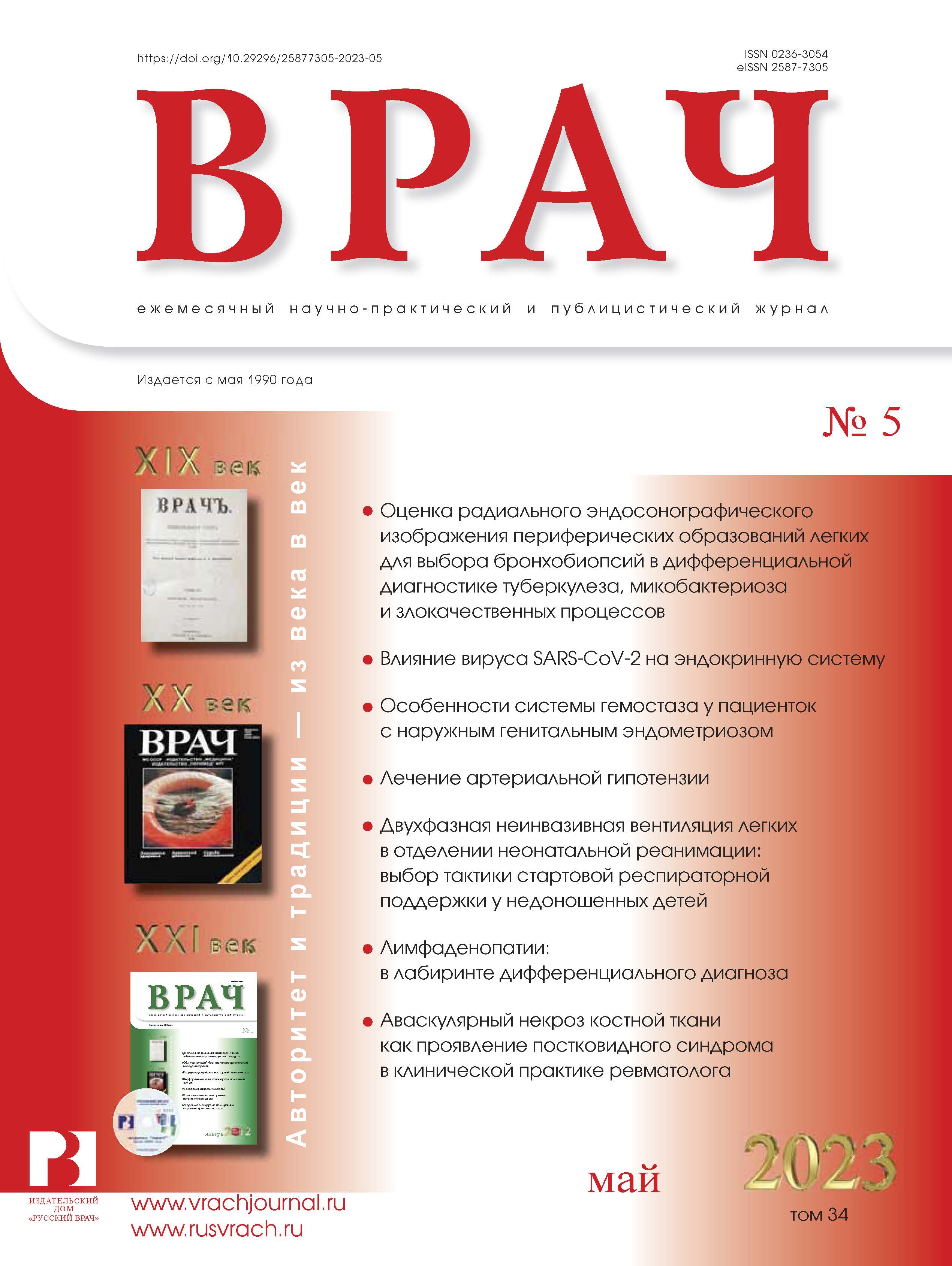Avascular necrosis as a manifestation of post-COVID syndrome in routine practice of rheumatologist
- Authors: Bazina I.B.1, Krechikova D.G.2, Kozyrev O.A.1, Pavlova M.V.1, Loginova I.A.1, Kononova V.A.1, Yakub L.G.1
-
Affiliations:
- Smolensk State Medical University
- Clinical hospital «RZhD-Medicine»
- Issue: Vol 34, No 5 (2023)
- Pages: 43-47
- Section: From Practice
- URL: https://journals.eco-vector.com/0236-3054/article/view/472118
- DOI: https://doi.org/10.29296/25877305-2023-05-07
- ID: 472118
Cite item
Abstract
Avascular necrosis as a part of post-COVID syndrome requires increased attention of physicians due to significant misfunction of musculoskeletal system, increased disability, and frequently requires surgical intervention. It is known that hypercoagulation, thrombosis as well as systemic corticosteroid therapy during severe coronavirus infection play an important role in the development of avascular necrosis. A case report of progressive avascular necrosis in multiple loci accompanied by polyarthritis in a young man developed after severe COVID-19 is reported below.
Full Text
About the authors
I. B. Bazina
Smolensk State Medical University
Author for correspondence.
Email: billy_boss@mail.ru
Candidate of Medical Sciences
Russian Federation, SmolenskD. G. Krechikova
Clinical hospital «RZhD-Medicine»
Email: billy_boss@mail.ru
Candidate of Medical Sciences
Russian Federation, SmolenskO. A. Kozyrev
Smolensk State Medical University
Email: billy_boss@mail.ru
Doctor of Medical Sciences, Professor
Russian Federation, SmolenskM. V. Pavlova
Smolensk State Medical University
Email: billy_boss@mail.ru
Russian Federation, Smolensk
I. A. Loginova
Smolensk State Medical University
Email: billy_boss@mail.ru
Russian Federation, Smolensk
V. A. Kononova
Smolensk State Medical University
Email: billy_boss@mail.ru
Russian Federation, Smolensk
L. G. Yakub
Smolensk State Medical University
Email: billy_boss@mail.ru
Russian Federation, Smolensk
References
- Насонов Е.Л., Лила А.М., Мазуров В.И. и др. Коронавирусная болезнь 2019 (COVID-19) и иммуновоспалительные ревматические заболевания. Рекомендации Общероссийской общественной организации «Ассоциация ревматологов России». Научно-практическая ревматология. 2021; 59 (3): 239–54 [Nasonov E.L., Lila A.M., Mazurov V.I. et al. Coronavirus Disease 2019 (COVID-19) and Immune-mediated Rheumatic Diseases. Recommendations of the Association of Rheumatologists of Russia. Rheumatology Science and Practice. 2021; 59 (3): 239–54 (in Russ.)]. doi: 10.47360/1995-4484-2021-239-254
- Lopez-Leon S., Wegman-Ostrosky T., Perelman C. et al. More than 50 long-term effects of COVID-19: A systematic review and meta-analysis. medRxiv. 2021; 2021.01.27.21250617 (Preprint). doi: 10.1101/2021.01.27.21250617
- Fan B.E., Umapathi T., Chua K. et al. Delayed catastrophic thrombotic events in young and asymptomatic post COVID-19 patients. J Thromb Thrombolysis. 2021; 51 (4): 971–7. doi: 10.1007/s11239-020-02332-z
- Zhang W., Zhao Y., Zhang F. et al. The use of anti-inflammatory drugs in the treatment of people with severe coronavirus disease 2019 (COVID-19): The Perspectives of clinical immunologists from China. Clin Immunol. 2020; 214: 108393. doi: 10.1016/j.clim.2020.108393
- Zhang Y., Xiao M., Zhang S. et al. Coagulopathy and antiphospholipid antibodies in patients with COVID-19. N Engl J Med. 2020; 382 (17): e38. doi: 10.1056/NEJMc2007575
- Karaarslan F., Güneri F.D., Kardeş S. Long COVID: Rheumatologic/musculoskeletal symptoms in hospitalized COVID-19 survivors at 3 and 6 months. Clin Rheumatol. 2022; 41 (1): 289–96. doi: 10.1007/s10067-021-05942-x
- Насонов Е.Л., Бекетова Т.В., Решетняк Т.М. и др. Коронавирусная болезнь 2019 (COVID-19) и иммуновоспалительные ревматические заболевания: на перекрестке проблем тромбовоспаления и аутоиммунитета. Научно-практическая ревматология. 2020; 58 (4): 353–67 [Nasonov E.L., Beketova T.V., Reshetnyak T.M. et al. Coronavirus disease 2019 (COVID-19) and immune-mediated inflammatory rheumatic diseases: at the crossroads of thromboinflammation and autoimmunity. Rheumatology Science and Practice. 2020; 58 (4): 353–67 (in Russ.)]. doi: 10.47360/1995-4484-2020-353-367
- Zuo Y., Zuo M., Yalavarthi S. et al. Neutrophil extracellular traps and thrombosis in COVID-19. medRxiv. 2020; 2020.04.30.20086736 (Preprint). doi: 10.1101/2020.04.30.20086736
- Chan K.L., Mok C.C. Glucocorticoid-induced avascular bone necrosis: Diagnosis and management. Open Orthop J. 2012; 6: 449–57. doi: 10.2174/1874325001206010449
- Drescher W., Schlieper G., Floege J. et al. Steroid-related osteonecrosis – an update. Nephrol Dial Transplant. 2011; 26 (9): 2728–31. doi: 10.1093/ndt/gfr212
- Assouline-Dayan Y., Chang C., Greenspan A. et al. Pathogenesis and natural history of osteonecrosis. Semin Arthritis Rheum. 2002; 32 (2): 94–124.
- Xie L., Liu Y., Fan B. et al. Dynamic changes of serum SARS-Coronavirus IgG, pulmonary function and radiography in patients recovering from SARS after hospital discharge. Respir Res. 2005; 6 (1): 5. doi: 10.1186/1465-9921-6-5
- D Orth S.A., Vijayvargiya M. A paradigm shift in osteonecrosis treatment with bisphosphonates: A 20-year study. JB JS Open Access. 2021; 6 (4): e21.00042. doi: 10.2106/JBJS.OA.21.00042
- Horikawa A., Miyakoshi N., Hongo M. et al. Treatment of spontaneous osteonecrosis of the knee by daily teriparatide: A report of 3 cases. Medicine (Baltimore). 2020; 99 (5): e18989. doi: 10.1097/MD.0000000000018989
Supplementary files








